History of Pioneers – Diabetes testing
The Development of Hemoglobin A1c (HbA1c) fractionation quantitative analyzer
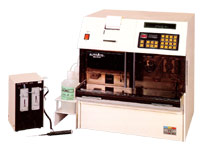
A1c analyzer (AUTO A1c)
In the summer of 1979, a development theme for a new instrument was determined, and a team of 6 – 7 engineers of machines, electronics, and software was organized. The theme was to develop a testing instrument using hemoglobin A1c (HbA1c) analytical column, which was a collaborative project of Sekisui Chemical Co., Ltd Central Research Institute and Osaka City University Medical School. In those days, it was not practical to measure HbA1c because the hemoglobin analyzer was too expensive and difficult to use, and it took as long as 24 hours for measuring. The goal for the development team was producing a single-analyte hemoglobin analyzer which could be operated even by a lay user on a daily basis.
Hemoglobin A1c and High Performance Liquid Chromatography (HPLC) Method
HbA1c, a type of glycated protein, is a binding of hemoglobin (protein) and glucose (sugar). HbA1c accounts for about 4 to 15 % of total hemoglobin. Since HbA1c represents the average blood glucose level of the past 2 months, it is an indispensable test item for diabetes diagnosis and care.
Measuring HbA1c requires fractionating hemoglobin into various different types of hemoglobin for quantification where the proportion of the different hemoglobin is calculated. Liquid Chromatography (LC) method was typically used for this.
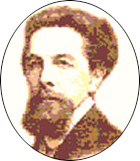
(1872-1919)
Liquid chromatography has a long history. It is said that it was originated in a discovery by a Russian botanist. The Russian botanist Mikhail S. Tswett (1872-1919) found that pigment composition became separated when plant pigment (chlorophyll) together with petroleum ether went through calcium carbonate layer. High Performance Liquid Chromatography (HPLC), which is faster liquid chromatography, is now the necessity in separation analysis.
When the new analyzer was being developed, HPLC instruments were on the market as general-purpose instruments. However, they were used only in university laboratories, professional analysis companies, and some test institutions, because they were huge and complicated system that required expert operators to keep stable use condition. In addition, even small changes in flow volume, pressure, temperature, and chromatography column would cause a big difference in the test result, so that people believed that HPLC was not suitable for quantitative analysis in clinical settings.
Under the situation, our company’s engineers worked hard on what would make it possible to bring in HPLC to clinical fields.
They came to the conclusion that the key was the performance stability and the price of the system. In HPLC, the solution sending pressure sometimes goes up to 50Kg/cm2 or more (the same pressure you get in 500m water depth), so the new analyzer needed many unusual components that were most unlikely in ordinary automatic biochemical test instrument (such as high-pressure solution sending pump, high-pressure bulb, high-pressure damper etc). If we had bought all of these components, it would have cost us tens of millions of yen. Thus, we decided to make the components in our company, making the best of all the HPLC techniques that had been developed until then. Most of the technical challenges were totally new for our development team — development of flow cell optical system with small dead volume and good linearity, high-pressure pump with little pulse, high-pressure injection bulb, floating point calculation software with wide dynamic range, control of new microcomputer system, etc. We achieved them one by one, and made high-quality and low-price components, and finally succeeded in developing a HPLC system for high performance at reasonable price that could be accepted by general hospitals and test institutions.
Our company took charge of the development of the instruments and Sekisui Chemical took charge of the development of the chromatography column. Together we gave birth to HA-8110, the world’s first HPLC HbA1c fractionation quantitative analyzer.
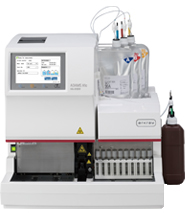
The Development of Hemoglobin A1c (HbA1c) fractionation quantitative analyzer
Promotion of Hemoglobin A1c in VENSONIC seminar
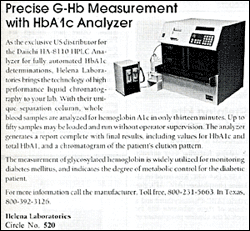
Today people know that HbA1c is highly important for diabetes study, however, in the 1970s, when HA-8110 was being developed, nobody knew about HbA1c in Japan, except some research pioneers. The measurement method itself was not general so that HbA1c was not applied in clinical settings. Only some researchers were studying the glycation of blood hemoglobin (binding of hemoglobin and sugars or its metabolites in blood) of the diabetics. There were not many literatures about HbA1c, and none in Japanese. Some was performing the measurement of HbA1c using mini column method in the U.S.A. Other than that, it was not too much to say nobody knew what HbA1c was and what it was for.
Under the circumstances, practical application of the measurement of HbA1c achieved by HA-8110 created a sensation all over the world as well as in Japan.
The usability of HbA1c in diabetes screening and as patients’ control indicator was obvious, but HbA1c measurement by HPLC method was not covered by insurance in those days. (HbA1 was covered by insurance.)

ARKRAY talked to academic societies and succeeded in organizing a study group about HbA1c with doctors noted for their diabetes study. For discussing the study outcomes, we held VENSONIC seminars all over in Japan. VENSONIC is a combination term of “venture” and “sonic.” It was made by a leading authority on diabetes, Dr. Shigeaki Baba, Kobe University that time, with the hope that ARKRAY’s venture spirit and new knowledge would spread further. VENSONIC seminar invited leading A1c researchers from abroad and became highly recognized as ARKRAY’s study support activity.
After this, the success of this kind of research was recognized and it became covered by medical insurance. Hbf (Hemoglobin F), which was not believed to exist in adults, was then recognized using this method and came to be used as part of the HPLC method.
We saw diabetes in proper perspective and continued our study firmly believing that HbA1c was necessary for diabetes testing. This made basis of today’s diabetes testing and it is still our pride.
Development of Cap-Piercing mechanism
In 1994, about 13 years after the development of HA-8110, the third generation of the HA series, HA-8130 was released.

The greatest feature of HA-8130 is the Cap-Piercing mechanism, where blood sample is drawn into the system without removing a cap of a vacuum blood collection tube. Before Cap-Piercing, blood drawing was performed in a troublesome and dangerous way; a cap of each vacuum blood collection tube was removed before drawing blood sample and it was put back on after drawing. The Cap-Piercing method not only reduced workload of opening and closing caps but also helped to protect lab technicians from possible infections.
We faced difficulties in the development of the Cap-Piercing mechanism. After an injection needle sticks a cap of a vacuum blood collection tube several times, the needle tip gets worn and dull, and the needle can no longer stick a cap. Since HA-8131 blood sampling needle sticks tens of thousands of caps annually, we needed to come up with an idea of a needle which would not get dull even in frequent sticking. We came up with an idea: traditional phonograph needle. A phonograph needle traces record grooves, which are like sandpaper, at high speed, but the needle does not become worn easily. This is because the needle tip is made from the substance with high degrees of hardness such as diamond or sapphire. In addition, the diameter of a phonograph needle tip is 0.5mil (about 0.012mm) and that is adequate tip for sticking the rubber cap of a vacuum blood collection tube.
We talked about the idea to a jewelry maker, who handled diamond and sapphire, and got a response that sapphire could be set on the tip of the injection needle. We made a prototype needle with sapphire and performed a durability test. The result showed that the sapphire-tipped needle remained sharp after more than 100,000 sticks. This is how the piercing needle, an essential item for the Cap-Piercing method, was developed.
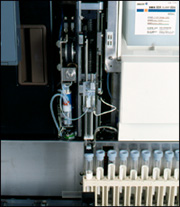
(adopted to HA-8160)
HA series was developed in cooperation with the major general chemical maker, and was evolved furthermore with the collaboration from a jewelry maker, who has no relation with clinical test. Now HA series has become a product with no equal. HA series went through improvements and they are widely used as a flagship model in the A1c measurement even today. We believe that the performance of HA series reflects the fact that we took all the available means, continued challenging, and did not give up on the development of better instrument.
